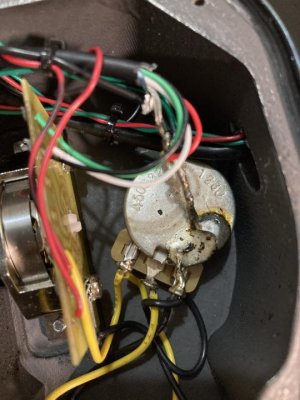Hi,
I have a lovely Vigier Ultrablues, currently HSS although planning on making that HSH. I'm told by the UK Vigier distributor that the volume pot is 1 Meg. It has no treble bleed circuit at all!
I want to be able to control gain using the volume knob but really want to lose as little treble as possible. I was told by a tech once that there was a danger of things sounding too trebly as the volume gets turned down....but as I'mm yet to ever experience that, so far I'm discounting that concern.
So the question is...based upon a 1 meg volume pot, what do you consider to be the most effective treble bleed circuit for my guitar?
Picture of the controls in case it's of any use.

Thanks,
Andy
I have a lovely Vigier Ultrablues, currently HSS although planning on making that HSH. I'm told by the UK Vigier distributor that the volume pot is 1 Meg. It has no treble bleed circuit at all!
I want to be able to control gain using the volume knob but really want to lose as little treble as possible. I was told by a tech once that there was a danger of things sounding too trebly as the volume gets turned down....but as I'mm yet to ever experience that, so far I'm discounting that concern.
So the question is...based upon a 1 meg volume pot, what do you consider to be the most effective treble bleed circuit for my guitar?
Picture of the controls in case it's of any use.

Thanks,
Andy
